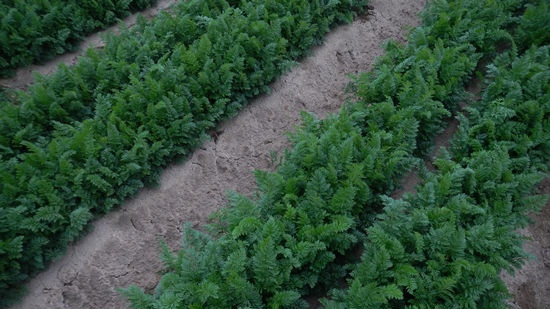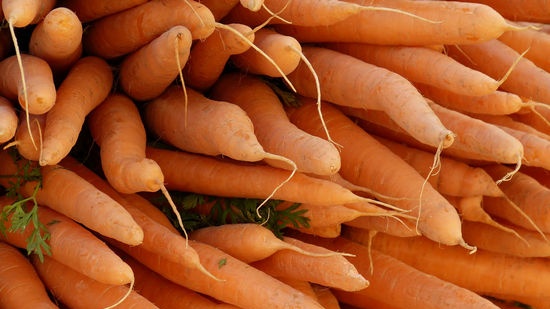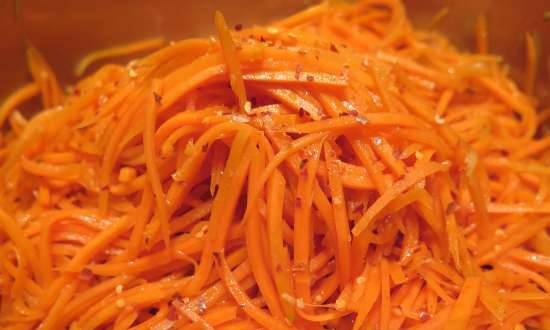|
 Carrots love loose soils, free from weeds. In crop rotation fields for carrots, if possible, plots with sandy loam and light loamy soils, as well as peat soils of drained bogs, should be allocated. On dense clay soils, carrots develop poorly and give ugly root crops. Carrots love loose soils, free from weeds. In crop rotation fields for carrots, if possible, plots with sandy loam and light loamy soils, as well as peat soils of drained bogs, should be allocated. On dense clay soils, carrots develop poorly and give ugly root crops.
Sowings of carrots can be placed on plots with any predecessor, except for umbrella ones. The plot is selected with a flat surface. Ridges and ridges are used in areas with excessive moisture, on poorly permeable moist and heavy soils with a shallow arable layer and a high standing of groundwater.
Carrots can be planted on the 2nd or 3rd field of the crop rotation for mineral fertilizers. It responds well to complete mineral fertilization.
Mineral fertilizers are applied for plowing in the spring. When using furnace ash, it must be applied from 7 to 9 centners per hectare.
In areas with an insufficient amount of organic matter in the soil, humus is introduced in an amount of 30-40 tons per hectare.
Fresh manure has a negative effect on carrots, it increases the percentage of ugly root crops. However, on heavy soils, where improvement of the structure is required, and on soils with insufficient amounts of organic matter, direct application of manure under carrots in an amount of 20-30 tons per hectare gives good results.
Carrots respond well to the introduction of ventilated peat in the amount of 40 tons per hectare, or peat-feces in the amount of 20 tons per hectare.
Seeds for sowing must be thoroughly cleaned of weed seeds and other impurities and checked in advance for germination. The seeding rate is 6 kg per hectare, and when sowing on a bundle product is 8 kg per hectare.
Sowing of carrots is done 2-line, tape.
Carrot seeds germinate slowly. Seedlings appear on the 15th and even on the 20th day after sowing. To accelerate germination, the seeds are soaked until they swell for a day. They must be dried before sowing.

Significantly accelerates the emergence of seedlings and the yield of beam products, and also increases the yield of sanding carrot seeds. Sanding work begins 20-25 days before sowing. Seeds, in the amount required for sowing, are poured into a bag and lowered into a bucket of clean water at a temperature of 15-20 °. They are left in water for 1 hour and stirred in a bag every 15-20 minutes. Then the bag with the seeds is removed, the water is allowed to drain, the seeds are slightly squeezed out and poured into bowls or other dishes with a wide bottom in a layer of 3-5 cm. The bowls are covered with a wet cloth and left for 4-5 days in a room with a temperature of 15-20p. The seeds swell, but their germination is not allowed. They are stirred 5-6 times a day. The lid on the seed dish should be wet at all times. After 4-5 days, the seeds are mixed with clean river sand, dried in the air. For 200 g of carrot seeds, 1 kg of sand is taken.
This is done as follows: sand is poured into the bottom of a box 20 cm high in a layer of 1-3 cm, moistened, covered in 2-3 layers with gauze or cloth, then put, without adding 3-5 cm to the edges of the box, seeds, mixed with sand. Cover the top with gauze or a cloth and pour 1-3 cm of moistened sand. All this is loosely covered with a lid. The box is placed in the cellar on ice, where the temperature should be 0 ° with permissible fluctuations up to + 3 °. The seeds are left in the cellar for 10 days. If sowing is delayed, they can be kept on ice for up to 30 days. Before sowing, the sand from the seeds is sifted out. If the mixture is damp and the sand does not separate well, then the mixture is slightly dried. The sand must be sifted out quickly so that the seeds do not have time to dry out. The sifted seeds are weighed.
If, approximately, the weight of seeds taken for sowing 1 hectare was 6 kg, and after sanding it increased to 12 kg, then the seeder is set for seeding at 12 kg.During sowing, the seeds should be mixed more often in the seed box of the seeder. When sown with dry and wet carrot seeds, add 5% of lettuce seeds to them.
Carrot seeds begin to germinate at 2–3 ° C. Seedlings tolerate short-term temperature drop to 4-5 ° C without harm. Therefore, sowing carrots should be done as early as possible, at the first opportunity of pre-sowing soil cultivation. Sowing is carried out with seeders, belts, in 2-3 lines. The distance between the lines (three-line tape) is 37 cm, and the two-line tape is 20 cm. Between the tapes in the first case, 60 cm is given, and in the second - 45-50 cm.
Carrot seeds are planted to a depth of 1-2 cm, depending on the nature of the soil and the degree of its moisture.
Carrots give a high yield with systematic and timely cultivation and a shelf of crops. During the summer, there are 4 cultivations and 4 shelves. They should be started immediately after the designation of the salad shoots, but before the carrot shoots appear.
On heavy soils, when a crust forms, loosening is carried out before shoots appear.
In this case, the field is harrowed with a light harrow across the direction of the lines.
In dry weather, if the field is clear of weeds and the surface is loose, the area is not harrowed.
Breakthrough sowing has a big impact on increasing yields, especially on poor soils. The first thinning is done during the period when the plants will have 1-2 leaves. The distances between the plants are left at 1–2 cm. The second thinning is 20–30 days after the first, the roots at this time are suitable for bunch goods. When thinning, the soil must be sufficiently moist. In drought, thinning causes severe wilting of the remaining plants. The final distance between plants in rows is given: on soils of high fertility 2-3 cm, for other soils at least 4 cm.

2-3 weeks after the emergence of shoots, with a weak growth of carrots, fertilizing is done with organic fertilizers: slurry, bird droppings or mullein. For fertilizing irrigation, 1 bucket of slurry in tubs is diluted 3-4 times with water. One third of the tubs are filled with mullein and poultry droppings, poured with water and closed. The contents are mixed several times a day. When the liquid stops foaming (after 7-8 days), it is diluted with water at the rate of: 1 bucket of bird droppings for 8-12 buckets of water, and mullein for 3-5 buckets. The younger the plant and the drier the weather, the more water is added. When using slurry as a top dressing, 10 g of superphosphate is added to a bucket of undiluted fertilizer and 10 g of potassium salt to a bucket of bird droppings.
The fertilization technique for feeding is the same as for growing other crops.
A bucket watering can of the solution is poured into a groove with a length of 10 to 15 running meters and is closed. Approximately 20 days after the first feeding, it is repeated by applying fertilizers in the middle of the rows.
Top dressing is done, in addition to organic fertilizers, mineral fertilizers. To prepare the first top dressing, a bucket of water is taken: ammonium nitrate 15 g, superphosphate 40 g and potassium salt 20 g, for the second: ammonium nitrate 25 g, superphosphate 30 g, potassium salt 30 g.
Carrots are harvested before the onset of frost. The root vegetables are dug up, lightly shaken off the ground, and piled up for pruning to follow the digging up. Root crops going for food are cut flush with the head; the tops of the testes are left 1-1.5 cm. Sorting is carried out simultaneously with pruning. Root crops are piled up and covered with tops.
I. Osipov - Agroindication
|
 Carrots love loose soils, free from weeds. In crop rotation fields for carrots, if possible, plots with sandy loam and light loamy soils, as well as peat soils of drained bogs, should be allocated. On dense clay soils, carrots develop poorly and give ugly root crops.
Carrots love loose soils, free from weeds. In crop rotation fields for carrots, if possible, plots with sandy loam and light loamy soils, as well as peat soils of drained bogs, should be allocated. On dense clay soils, carrots develop poorly and give ugly root crops.










